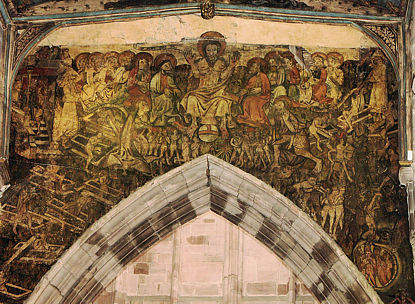Holy Trinity church, Coventry, Warwickshire (†Coventry) C.15
Doom
This vast painting, which has been several years in restoration (hence the presence in some of these photographs of newly plastered cracks and the odd scaffolding pole), is probably the most impressive Doom now remaining in an English church. Most of the features commonly found in paintings of this subject are present, along with some much rarer ones. The painting is placed in the standard position above the chancel arch in this very lofty church. The multitude of figures, the tumultuous detail, and the urgency with which the awesome moment – the culmination and end of all human history – is narrated are immensely striking.
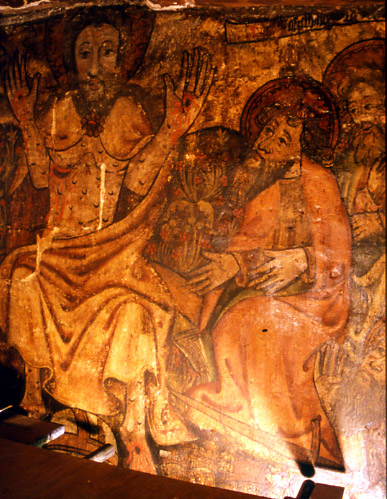
Of the rainbow on which the Judging Christ usually sits there is no sign, but the plethora of detail would have obscured this anyway. His distinctly Semitic physiognomy is unusual – a departure from the often bland and indeterminate facial features more commonly seen. He wears, thrown open to show the wound in his side, an elaborate robe fastened at the throat with a jewelled clasp. Beside him at the right is St John the Evangelist.

In a corresponding position on Christ’s left (photo, right) the Virgin Mary, also interceding for sinners, bares her breast in the way that so incensed later reformers like Johannes Molanus, whose indignation at this detail is quoted on the page for the Doom at Ickleton in Essex.
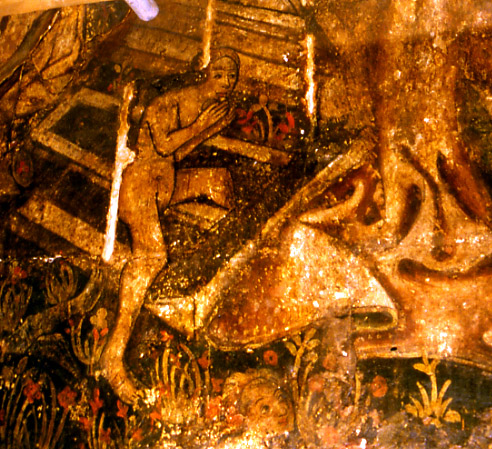
All around, graves open and the dead climb out. For once, it may be possible to infer something about their next destination from their expressions, attitudes and position. A calm-faced woman clasps her hands in prayer as she leaves her grave beside the folds of the Virgin’s robe, while another, just visible in the centre at the lower edge of the photo at the right wears an expression of positively beatific assurance. These two seem to destined to climb the steps to heaven (very hard to see at the extreme upper left of the painting, beyond the trumpeting angel).
Others among the resurrected have little cause for comfort. Along with the sellers of short-weight bread who probably feature in the painting of the Seven Deadly Sins at Hessett in Suffolk, vendors of another medieval staple, ale, were likely to arouse the ire of their contemporaries. On December 6, 1345 in Southwold, Suffolk, Johanna de Corby was prosecuted, possibly for the first time, but certainly not the last, for selling ale in unmarked measures. Ale and beer are easily watered down to maximise profit – the practice was widespread and alewives were notorious for it. Two such offenders, clearly destined for Hell, feature in this Doom.
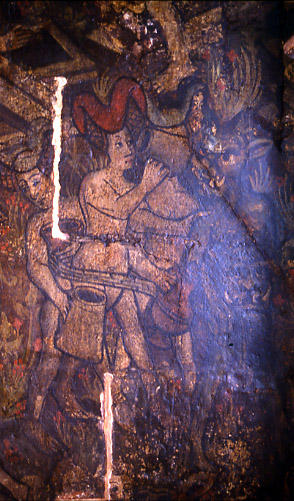
Amid the usual chaotic background of Hell in the photograph at the right, it should be fairly easy to locate the very modish bright red hat worn by one of the alewives. She clutches a large black devil by the shoulder with her left hand, and brandishes a tankard invitingly in her right. A second alewife, similarly behatted behind her and clutching a bowl, reaches around to proffer a larger tankard, and a third, largely lost in the melée but certainly present, given the number of arms and legs visible in this group, also tries to offer her wares.
Devils are however, not to be placated by drink, as is clear from the heavy chain, one of several discernible among the details on this side of the painting, coralling these women together. Another chain loops around the waist of a hell-destined unfortunate at the right in the photograph below, while a devil with huge pointed ears carries off another slung over his shoulder. This figure too appears to be clutching a large urn-like vessel, and it is clear that a moralising point, not a killjoy stricture against the imbibing of ale, which was universally drunk, but an indignant response to the cheating involved, is being made here. The flauntingly inappropriate headgear worn by the alewives simply adds insult to injury, and must moreover have been in breach of more than one medieval sumptuary law.
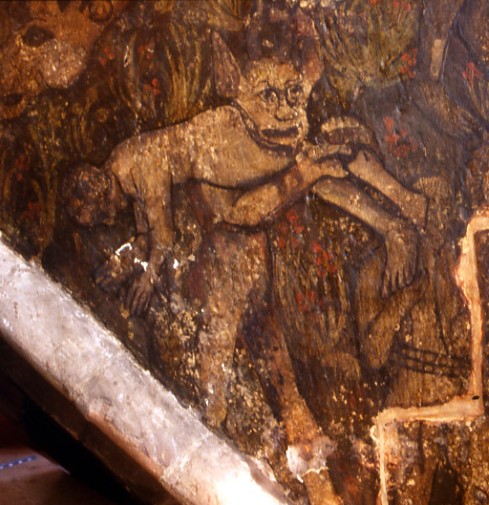
Hell itself is shown in the photograph below at the left as the gaping mouth of a large monster-figure, coloured black and with huge pointed fangs but otherwise of indeterminate species. An enormous and disconcertingly human-looking eye glares out at the upper right, while several figures, standing literally in flames, cluster in the Hell-mouth. From the point of view of someone standing in the church during service-time, this detail, at the lower edge of the painting, would have been one of the easiest to make out, especially when the colours were bright and new. It must have been quite terrifying.
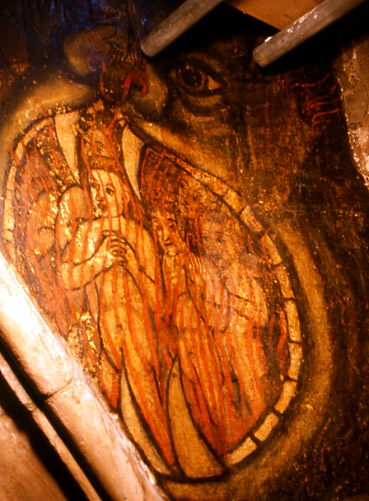
The bleeding right foot of the Judging Christ will help to locate a group of people awaiting judgement at the upper left of the painting and shown in the detail below at the right. The orb of the world, his metaphorical footstool, is at the extreme upper right of the photograph, and there are two bareheaded figures kneeling nearest the foot, possibly Adam and Eve, possibly local benefactors, past or present, of the church, a category which certainly need not rule out the celebrated Godiva (Godgifu) and her husband Earl Leofric, since both were known for their generosity to religious houses, and both were also very wealthy. But whoever she may have been, this woman’s very expressive face is beautifully painted.
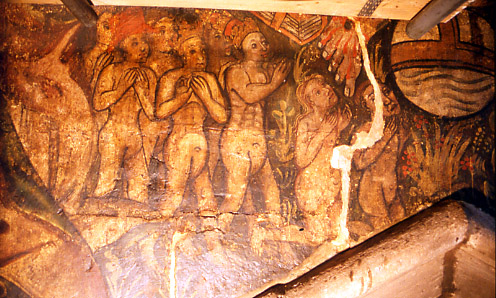
Beyond these two at the left a pope wearing the triple Tiara of the Papacy, a king with a crown and a cardinal with a broad-brimmed red hat stand in line, with others, including at least one woman, behind them.
One of the most interesting details here though is very easy to overlook. It is the red book – a typical medieval volume with a fastening strap – lying very close to Christ’s foot. The book is closed, and this is a symbolic point, I think. The Word of God is now superseded by the final work of God in the world. Or as He himself put it at the end of the York Cycle of Mystery Plays “Now is fulfilled all my forethought/For ended is each earthly thing”.²
Website for Holy Trinity church, Coventry
¹ Johanna de Corby’s prosecution
² The Merceres’ Play of the Judgement, The York Cycle of Mystery Plays, ed JS Purvis, SPCK,1957, p.382
Main photograph © Rob Orland, Historic Coventry
